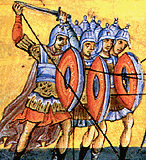Soldiers: evolution and social status
 uring the last two centuries of the Byzantine Empire, the overwhelming majority of those serving in the army were
uring the last two centuries of the Byzantine Empire, the overwhelming majority of those serving in the army were
 mercenaries. Their numbers were few, reflecting the poor financial situation of the state, and their combat-worthiness left much to be desired. mercenaries. Their numbers were few, reflecting the poor financial situation of the state, and their combat-worthiness left much to be desired.
As regards the navy, it was essentially non-existent and every time there arose a need for a fleet, the Byzantines were obliged to seek the assistance of the Italians, in return for which they granted them commercial privileges.
During the late Byzantine period, efforts were made from time to time to strengthen and reorganise the army. The intensity and size of the effort depended each time on the financial situation of the state as well as on its need for military forces.
John III Vatatzes
(1222-1254) and
Andronikos II
(1282-1328) took positive measures, which contributed to the improvement of the financial, and therefore of the social status, of the soldiers. The policies of
Michael VIII
and the loss of Asia Minor produced the opposite results. As the state shrank in size and more territories were surrendered, the majority of the soldiers who had settled in Asia Minor were reduced to poverty as they had to abandon their land and seek refuge on European soil.
As regards the social and financial situation of the soldiers, it should be noted that, contrary to the previous periods of Byzantine history, the soldier of the late Byzantine period was now offered the possibility not only of acquiring a fairly large estate, but also of joining the ranks of the nobility. Those who rose on the social scale were mostly
pronoiarioi
or powerful pronoiarioi. Research indicates that the social status of the poorer pronoiarioi or engegrammenoi was different from that of the aristocracy, a fact which is confirmed by their joining forces in the political field alternatively with the aristocracy or with the common people.
See also: Pronoia
|